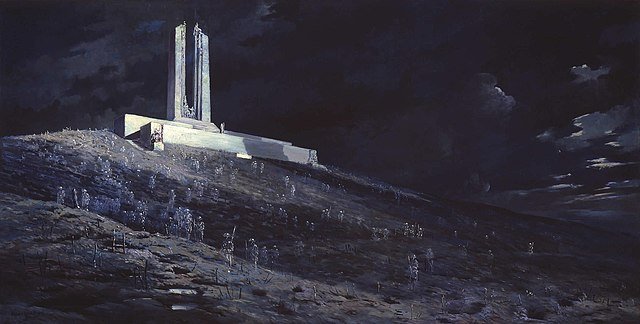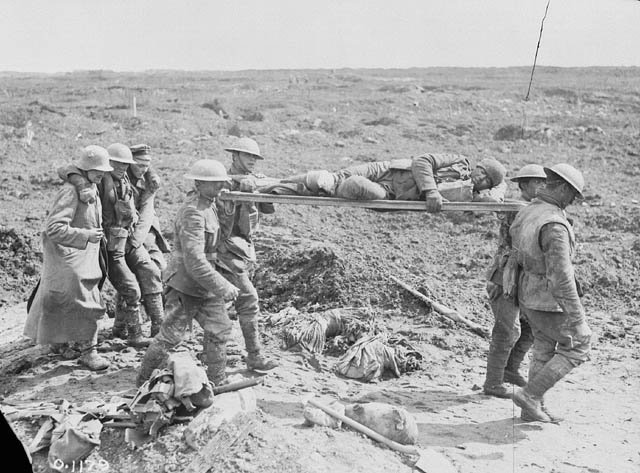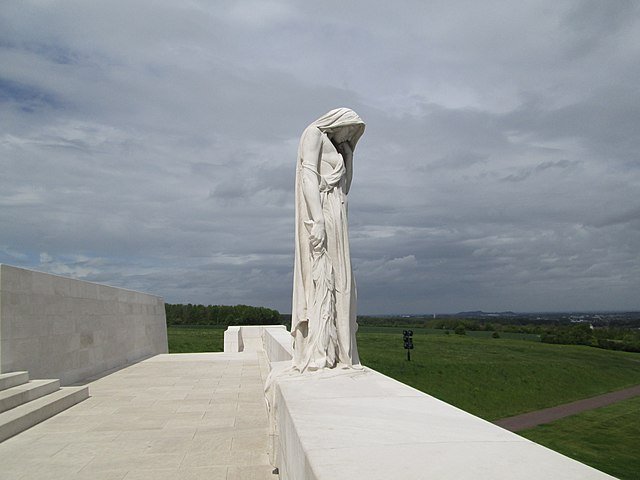Did Canada Come of Age at Vimy Ridge?

Ghosts of Vimy Ridge depicts ghosts of the Canadian Corps on Vimy Ridge surrounding the Canadian National Vimy Memorial.
“There they stood on Vimy Ridge that ninth day of April, 1917, men from Quebec shoulder to shoulder to men from Ontario; men from the maritimes with men from British Columbia and there was forged a nation, tempered by the fires of sacrifice and hammered on the anvil of high adventure.” — Lord Byng of Vimy
April 9th is Vimy Ridge Day in Canada. It’s not a public holiday. It is a day of remembrance and observances of what is often seen as a pivotal battle in Canadian history. The WW1 Battle of Vimy Ridge marked the first time the Canadian Corps fought as a single unit and it was a decisive victory for this young nation.
The battle didn’t have particular influence on the outcome of WW1. Immediately after and often since then the battle is presented as Canada’s coming of age as a nation. The French 19th century writer, Ernest Renan in his essay, “What is a Nation?” had wrote, “nations are made by doing great things together.”
Did the Battle of Vimy Ridge birth a nation? I’ll share my thoughts after I provide some background on the battle and the symbols which have become its legacy.
Canada at the Start of WW1
In 1914 Canada was a self-governing Dominion and part of the British Empire. We made our own decisions at home but foreign policy was dictated by Britain. When Britain declared war on Germany in August 1914, Canada and the independent colony of Newfoundland were also at war.
While we had no choice about going to war, the choice of how many to send remained with the Canadian parliament. The government would determine the nature and extent of the war effort. The population was barely 8million people.
Raising An Army
The government chose not to mobilize the militia after war broke out. They chose instead to raise the Canadian Expeditionary Force. In September 1915 a second Canadian Division arrived in France, followed by a third in late 1915 and a fourth in 2016. These four divisions became the Canadian Corps. A total of 600,000 enlisted prior to conscription in late 1917.
Much of Canada’s population at the time were either British immigrants or family of Brits. Support for the war was strong in English Canada which spurred on the enlistment rate at first. As the war dragged on and the casualty lists grew, that initial enthusiasm for King and country waned. French Canada didn’t feel a deep loyalty to either England or France and were reluctant to participate.
Canadian battalions were sent where ever the British wanted them. They were under British command. That started to change in early 1917. The four Canadian divisions with a total of 100,000 troops were brought together in France. They were under the command of the British General Sir Byran Byng but they were to fight together for the first time.
Preparing For The Battle of Vimy Ridge
Their role in the British offensive which became known as the Battle of Arras was to take Vimy Ridge. It was a 9km escarpment in open countryside north of the Town of Arras in France.
The Germans had captured the ridge in 1914 and were well entrenched. Previous efforts by the French and the British to dislodge them had failed leaving over 150,000 killed or wounded.
During the three years the Germans controlled the ridge, they had heavily fortified it with three lines of trenches, a network of barbed wire, concrete bunkers, underground chambers for shelter which were interconnected with communications trenches and tunnels. At the widest point, there was 8km between the first and third line of defense.
The four Canadian divisions along with the British and Canadian support units moved into a staging area west of the ridge in early 1917. Preparations and rehearsals for the attack took place largely at night during March.
Lessons learned at the Somme brought innovation to the tactics used at Vimy A new shell fuse used by the artillery meant shells exploded on contact rather than buried in the ground. Creeping artillery barrages pinning down defenders ahead of the waves of troops arriving were to be deployed. Night raids were carried out to unsettle the Germans, take prisoners and to collect intelligence.
Most importantly, 11 tunnels nearly 6km in length were secretly built under the wide open area in front of the German lines. The Canadian troops would come out in front of the German lines without having to cross the ‘no mans land’ in the first waves.
The Battle of Vimy Ridge

For a week prior to the attack, over 980 heavy artillery and field guns bombarded the German positions with over one million shells. The attack was set to start at daybreak on Easter Monday, April 9th.
The 15,000 Canadians from the four Canadian divisions would move up the slope in side-by-side formation with the British 17th attacking at the same time on the Canadians right flank forming the first wave of the attack. The weather helped hide the Canadians from the Germans but the wind-driven snow and sleep which swept the ridge also made conditions miserable.
Within hours the first three divisions had reached their objectives for the first day. At one point they had pushed the Germans back almost 5km. It was the greatest single day advance of the war to that point.
The 4th Division on the far left flank did not fare as well. They had the toughest objectives; Hill 145, the highest point on the ridge (later the location of Vimy Memorial) and another high point called the Pimple. Those two points were crucial if the Canadians were going to both take and hold the ridge.
Early bombardment wasn’t as effective as expected and battle plans didn’t implement as expected. Heavy losses including officers and objective not taken on the 9th. Hill 145 was taken on the 10th and on the 12th, in an hour of fierce combat during a driving snow storm, the Pimple was secured.
The Germans had lost the ridge. The Canadians had fought hard. There were 10,000 causalities including 3,598 dead. April 9, 1917 stands as the largest loss of life on a single day in our history. The Germans had 20,000 dead or wounded and 4,000 taken prisoner. Many of the dead on both sides have never been recovered. Most were buried in the mud of the battlefield.

Four Victoria Crosses were awarded. Military Crosses (MC) and Military Medals (MM) were also awarded. The three awards were the three highest awards for valour in the British Empire.
Cree sniper Henry Norwest of Fort Saskatchewan earned MM at Vimy Ridge while taking the Pimple. He was awarded a bar to the MM before being killed by enemy fire on 18 August 1918 during the Battle of Amiens. He had registered 115 official kills as a sniper during the war.
Lieutenant Charles S. Rutherford, a local WW1 veteran I knew, earned the MM at Vimy Ridge and went on to earn the MC and later the VC during the Battle of Amiens. He earned the VC on the 18th of August 1918.
Vimy Ridge was an incredible accomplishment for a young nation. General Byng would be promoted out of the Corps two months later. Arthur Currie, who had commanded a division at Vimy, would take command. He was the first Canadian commander of the Canadian Corps.
The Vimy Memorial
In October 1921 the government chose Toronto sculptor Walter Allward to design the Canadian National Vimy Memorial. The Canadian Government chose Hill 145 for the location of the Vimy Memorial with its commanding view of the surrounding countryside. In 1922 France granted to Canada in perpetuity 248 acres including Hill 145 and the surrounding battlefield for use as a memorial park.
The land surrounding the memorial remains largely untouched as it was following the battle. Many parts of it can not be safely walked on due to unexploded ordinance. The land in the vicinity of the memorial was cleared of ordinance.
The memorial took eleven years to build. It rests on a bed of 11,000 tonnes of concrete, hundreds of tonnes of reinforcing steel and 6,000 tonnes of limestone brought to the site from an abandoned Roman quarry on the Adriatic Sea.

There are twenty sculpted symbolic figures on the monument. The largest is known as Canada Bereft, a mourning figure, head bowed in sorrow represents the young nation of Canada grieving her dead. The figure overlooks the Douai Plain, gazing down at a symbolic tomb draped in laurel branches, a helmet and a sword. The figure was carved from a single 30-tonne block.
On the walls of the monument are the names of the 11,285 Canadians killed in France with no known graves. The inscription at the base of the Memorial, in both English and French:
TO THE VALOUR OF THEIR COUNTRYMEN IN THE GREAT WAR AND IN MEMORY OF THEIR SIXTY THOUSAND DEAD THIS MONUMENT IS RAISED BY THE PEOPLE OF CANADA
The 27 metre high pylons at the center of the Memorial represent Canada and France, two nations united to fight for a common goal. The figures at the top of the pylons represent the common goal — peace and freedom.
Six thousand veterans of the Battle of Vimy Ridge and their families were transported on five specially chartered ocean liners to the unveiling by King Edward VIII on July 26, 1936.
During WW2 the Canadian caretaker was captured by the occupying German forces leading to rumours that the Germans had damaged or destroyed it. After the liberation of France it was found to be in remarkably good repair thanks to a Belgium couple who looked after it throughout the war.
The Tomb of the Unknown Soldier

May 2000 one of the dead from Vimy Ridge was exhumed from the Cabaret-Rouge Cemetery and the remains were brought to Ottawa to be interned in the newly created Tomb of the Unknown Soldier which lies directly in front of the National War Memorial near Parliament Hill.
This unknown soldier became the only Canadian to be repatriated from the Battle of Vimy Ridge. Ceremonies were held at the cemetery and at Vimy Ridge where his name would have been inscribed on the memorial among the 11,285 killed in France with no known graves.
The flag-drapped casket was flown home to Canada where he lay in state in Parliament for the public to pay their respects before being interred in the tomb on May 28, 2000 where he lies representing the 28,000 Canadian war dead without known graves.
The Ninetieth Anniversary in 2007
The largest single-day loss of life in war since 1953 took place on April 9, 2007 while observances were taking place at the Vimy Ridge Memorial. Six soldiers from the Royal Canadian Regiment were killed in Kandahar, Afghanistan.
Did Canada Come of Age at Vimy Ridge?
From a military perspective, I could agree that Canada did indeed move from an emerging military presence into a formidable and respected fighting force. Canadians have had much to be proud of in the way their military has represented the country through conflicts and peacemaking over the generations.
The Battle of Vimy Ridge is the better known of Canadian accomplishments which serve as inspiration for those who followed. No matter how much our government has failed to properly supply our troops, the troops take pride in who they are and the legacy they represent.
That doesn’t answer the question if Canada came of age at Vimy Ridge.
I believe Vimy Ridge has contributed to our sense of national identity. It was not solely responsible for it. In the culture of the early 20th century, to be bloodied as a nation and to emerge in victory would have been indeed viewed as the forging of a nation.
Canada’s true forging as a nation has taken place in many areas, none more so than the struggle between the two solitudes, the English and the French. We are a nation of two founding languages and two founding cultures.
Throughout our history there has been a sort of uneasy truce between the two. At times we come together in solidarity and at other times we’re like squabbling children. Through it all, we’ve learned how to respect others and to value forging ties that bind over severing ties.
The two world wars produced bitter fights over conscription at home. Those fights strained relations between the two solitudes.
While some will point to Vimy Ridge as forging our nationhood. I’ll point to how we survived those bitter fights at home as the lasting test of our nationhood.
I will also pause and remember the horrible losses in the war that did not end all wars and all those who have been lost since to conflict.
We Will Remember Them.
Posted from my blog with SteemPress : https://idesofmay.com/2019/04/09/did-canada-come-of-age-at-vimy-ridge/
I forget that your nation's history is nowhere near as bloody as mine. By the time you entered WWI we'd fought 4 wars and didn't need to be bloodied in any nation's eyes. I know so little of your WWI history. Thank you for sharing this, to educate me.
We've lost family members in every war America has fought. I truly understand the pain and honor of this battle. May they rest in peace forever.
Our Tomb of the Unknown is probably our most sacred site. It goes back to the Civil War and includes remains from all our wars. It is the most solemn place I know.
WW1 wasn't actually the first war we were engaged in. Canada sent troops to South Africa during the Boer War. In fact a lot of those who signed up for WW1 initially had seen service in South Africa.
Thanks for a great piece of history.
War is sad, and I will personally never understand it.
While I was not born Canadian, I am now a Canadian citizen, but I did not know this story. You have told it so well and with gentleness. I am glad to have read it.
Thank you so much for sharing.
Awesome novel @shadowspub!!! Hehehe!
Unfortunately, the only ones who profit from wars are the perpetrators;
the rest loses....
Hi, @shadowspub!
You just got a 0.2% upvote from SteemPlus!
To get higher upvotes, earn more SteemPlus Points (SPP). On your Steemit wallet, check your SPP balance and click on "How to earn SPP?" to find out all the ways to earn.
If you're not using SteemPlus yet, please check our last posts in here to see the many ways in which SteemPlus can improve your Steem experience on Steemit and Busy.
Canada certainly has a fascinating history, with more twists than anyone would suspect!
Hi @shadowspub!
Your post was upvoted by @steem-ua, new Steem dApp, using UserAuthority for algorithmic post curation!
Your UA account score is currently 6.089 which ranks you at #294 across all Steem accounts.
Your rank has not changed in the last three days.
In our last Algorithmic Curation Round, consisting of 219 contributions, your post is ranked at #27.
Evaluation of your UA score:
Feel free to join our @steem-ua Discord server
Congratulations! This post has been chosen as one of the daily Whistle Stops for The STEEM Engine!
You can see your post's place along the track here: The Daily Whistle Stops, Issue 455 (04/12/19)